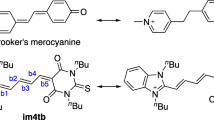Abstract
Di-, tetra-, and hexamethinemerocyanines were synthesized on the basis of barbituric and 1,3-dimethylbarbituric acids and heterocycles characterized by a strong (1-benzyl-1,2-dihydrobenzo[cd]indole), medium (1,3-dihydro-1,3,3-trimethyl-2H-indole and 3-ethyl-2,3-dihydro-1,3-benzothiazole), and strong electron-donor power (1,3-diphenyl-2,3-dihydro-1H-benzimidazole). Their solvatochromic properties were analyzed using both conventional parameters (absorption maxima and molar absorption coefficients) and centroids, oscillator strengths, widths, asymmetry and excess coefficients, and fine structure of the long-wave absorption bands, which were determined by mathematical processing (method of moments). A combination of these parameters unambiguously characterizes limiting electronic states of merocyanines (neutral polyene, polymethine, or charged polyene) responsible for the type of solvatochromism. Relations were found between solvatochromic properties, on the one hand, and donor-acceptor power of the terminal groups, length of the polymethine chain, and solvent nature, on the other. The difference in solvatochromism (up to reversal of sign) of merocyanines derived from barbituric acid and their analogs based on 1,3-dimethylbarbituric acid originates from both the difference in their electronic asymmetry and the ability of the NH groups in the former to participate in hydrogen bonding with proton-acceptor solvents.
Similar content being viewed by others
References
Mishra, A., Behera, R.K., Behera, P.K., Mishra, B.K., and Behera, G.B., Chem. Rev., 2000, vol. 100, no. 6, p. 1973.
Würthner, F., Wortmann, R., and Meerholz, K., Eur. J. Chem. Phys., 2002, no. 3, p. 17.
Imoto, K., Takahashi, K., Yamaguchi, T., Komura, T., Nakamura, J., and Muratay, K., Bull. Chem. Soc. Jpn., 2003, vol. 76, no. 12, p. 2277.
Kawamura, K., Chem. Lett., 2003, vol. 32, no. 11, p. 1068.
Bublitz, G.U., Ortiz, R., Marder, S.R., and Boxer, S.G., J. Am. Chem. Soc., 1997, vol. 119, no. 14, p. 3365.
Brooker, L.G.S., Keyes, G.H., and Heseltine, D.W., J. Am. Chem. Soc., 1951, vol. 73, no. 11, p. 5350.
Brooker, L.G.S., Craig, A.C., Heseltine, D.W., Jenkins, P.W., and Lincoln, L.L., J. Am. Chem. Soc., 1965, vol. 87, no. 11, p. 2443.
Kiprianov, A.I., Tsvet i stroenie tsianinovykh krasitelei (Color and Structure of Cyanine Dyes), Kiev: Naukova Dumka, 1979.
Reichardt, C., Solvents and Solvent Effects in Organic Chemistry, Weinheim: Wiley, 2003.
Ishchenko, A.A., Zubarovskii, B.M., Gromova, G.A., and Derevyanko, N.A., Zh. Org. Khim., 1987, vol. 23, no. 3, p. 621.
Cho, B.R., Je, J.T., Lee, S.J., Lee, S.H., Kim, H.S., Jeon, S.J., Song, O., and Wang, C.H., J. Chem. Soc. Perkin. Trans. 2, 996, no. 10, p. 2141.
Hammer, F.M., The Cyanine Dyes and Related Compounds, New York: Intersci., 1964.
Würthner, F., Synthesis, 1999, no. 12, p. 2103.
Ishchenko, A.A., Derevyanko, N.A., and Svidro, V.A., Dyes Pigments, 1989, vol. 10, no. 2, p. 85.
Ishchenko, A.A., Stroenie i spektral’no-lyuminestsentnye svoistva polimetinovykh krasitelei (Structure and Absorption and Luminescence Properties of Polymethine Dyes), Kiev: Naukova Dumka, 1994.
Burger, K., Solvation, Ionic and Complex Formation Reactions in Non-Aqueous Solvents, Budapest: Akad. Kiado, 1983.
Bach, G. and Daehne, S., Rodd’s Chemistry of Carbon Compounds. Vol. IVB. Heterocyclic compounds, Sainsbury, M., Ed., Amsterdam: Elsevier, 1997, chap. 15, p. 383.
Kiprianov, A.I. and Petrun’kin, V.E., Zh. Obshch. Khim., 1940, vol. 10, no. 7, p. 600.
Ishchenko, A.A., Vasilenko, N.P., Maidannik, A.G., and Balina, L.V., Zh. Org. Khim., 1989, vol. 25, no. 5, p. 1086.
Biggs, A.I., J. Chem. Soc., 1956, no. 7, p. 2485.
Gordon, A.J. and Ford, R.A., The Chemist’s Companion, New York: Wiley, 1972.
Author information
Authors and Affiliations
Additional information
Original Russian Text © A.V. Kulinich, N.A. Derevyanko, A.A. Ishchenko, 2006, published in Zhurnal Obshchei Khimii, 2006, Vol. 76, No. 9, pp. 1503–1520.
Rights and permissions
About this article
Cite this article
Kulinich, A.V., Derevyanko, N.A. & Ishchenko, A.A. Synthesis, structure, and solvatochromism of merocyanine dyes based on barbituric acid. Russ J Gen Chem 76, 1441–1457 (2006). https://doi.org/10.1134/S1070363206090167
Received:
Issue Date:
DOI: https://doi.org/10.1134/S1070363206090167



